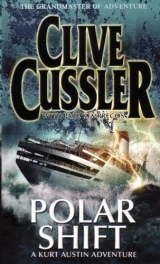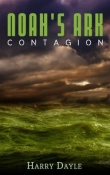
Текст книги "Polar Shift"
Автор книги: Clive Cussler
Жанр:
Научная фантастика
сообщить о нарушении
Текущая страница: 12 (всего у книги 26 страниц)
"Why not?"
"The Russians overran the lab in East Prussia, where he was said to be working. But Kovacs had already disappeared. After the war, the Soviets carried out research based on the Kovacs Theorems. The United States was aware of their work, and would have loved to talk to Kovacs. The significance of electromagnetic radiation was not lost on our military. There was a big conference years ago at the Los Alamos lab to talk about applied weapons technology based on his work."
"Home of the Manhattan Project? That was fitting," Austin said.
"In more ways than one. The manipulation of electromagnetic rays could be more devastating in its own way than a nuclear device. The military took Kovacs very seriously. Electromagnetic pulse weapons were tested during the first Gulf War. Some people claim that those experiments and similar ones conducted by the Soviets caused earthquakes, volcanic eruptions and weather disturbances. That's why I was interested in the bright light flashes in the sky."
"What's so significant about the bursts of light?" Austin asked.
"Many of the cases reported by witnesses to the Soviet and American experiments said they saw an aurora borealis, or great burst of light caused by electromagnetic transmissions," Hibbet said.
"Tell us more about these experiments," Austin said.
"There's a great deal of controversy over a project called HAARP, short for the High Frequency Active Aural Research Program, being carried out by this country. The idea is to shoot a focused electromagnetic beam into the ionosphere. It's been billed as an academic program to improve worldwide communications. Some people speculate that it's mainly a military project aimed at a wide range of goals, from 'Star Wars' defense to mind control. I don't know what to believe, but the project has its roots in the Kovacs Theorems."
"You said something about a Tesla coil," said Austin. "What did you mean?"
"It was a simple type of resonant transformer made up of two coils, actually. Pulses of energy are transferred from one to the other to produce a lightninglike discharge. You've probably seen them in the movies, where they seem to be a common fixture in the lab of the mad scientist."
Gamay had been listening intently to the discussion. She leaned forward. "We've talked about the transmission of these waves into solid ground or the atmosphere," she said. "What would happen if you sent them into the bottom of the sea?"
Hibbet spread his palms wide apart. "I don't have a clue. Ocean geology isn't my area of expertise."
"But it is mine," Paul Trout said. "Let me ask you a question, Al. Could amplified electromagnetic waves penetrate deep into the earth's crust?"
"Without question."
"In that case, it's possible that the transmissions could cause some anomalies in the earth's mantle in roughly the same way the HAARP program you talked about disturbed the atmosphere."
"What sort of anomalies?" Adler asked.
"Whirlpools and eddies, possibly."
"Could these create disturbances in the sea?" Austin asked.
Hibbet pinched his chin. "The swirling molten layer under the crust is what creates the magnetic field that surrounds the earth. Any disruption of the field has the potential to cause all sorts of disturbances."
Professor Adler pounded his fist on the table. "I knewI was right! Someone has been monkeying around with my ocean."
"But we're talking about vast distances and miles of surface material," Trout said, temporarily squelching Adler's exuberance. "My sense of this discussion is that it's going back to Joe's big spark plug. Or Al's coil. Even if the device turned out enormous power, it would still be puny compared to the mass of the earth."
Austin broke the brief silence that followed Trout's evaluation. "What if there were morethan one device?"
He pushed the laptop to the center of the table and slowly spun it around so everyone could see the blips surrounding the disturbed area.
Trout grasped the significance right away. "Fourships, each concentrating its power on a small area. That might work."
Austin nodded. "I'll show you something else that's interesting." He called up the image taken shortly after the Bellesank. "My guess is that one of these ships became a victim of the sea disturbances it created."
There was a murmur of agreement around the table.
"That might explain how,"Zavala said. "What I can't figure is why?"
"Before we answer that question," Austin said, "maybe we should concentrate on who .This isn't a case of someone making waves in a bathtub. Nameless and faceless people have gone to a great deal of trouble and expense to stir up the ocean. They have killed the crews of two ships, that we know of, and caused the loss of millions of dollars in property, in their quest for some nameless goal." He looked around the table. "Are we all ready to get down to work?"
Hibbet started to rise.
"I hope you're going to get more coffee?" Austin said with a grin.
Hibbet looked embarrassed. "No, actually, I was about to head into my office at NUMA. I assumed that you had all you need."
"Joe, tell Al about our 'Hotel California' rule."
"Glad to. It's like the old Eagles song, Al. Once you've been recruited into the Special Assignments Team, you can check out but you can never leave."
"We need your expertise in electromagnetism," Austin said. "It would be a great help if you could see from a technical point of view if these pipe dreams have any basis in reality. Where can we learn more about the Kovacs Theorems?"
"My best advice is to go right to the source. The research in this country was done in Los Alamos. There's even a Kovacs Society out there that's a repository for his work and documents. I've contacted them from time to time with questions."
Austin turned to Adler. "Could you work with Al and come up with a paper? Joe, building a fleet of floating power plants is a pretty big deal. Those dynamos were probably commercially built."
"I'll see if I can come up with a point of origin," Zavala said.
"We could be in New Mexico this afternoon and back here tomorrow," Gamay said.
Austin nodded. "Find out how far those experiments went and if they're still going on. We'll work up everything ever written about Kovacs. Maybe we'll find a nugget that will make it worth our while."
He thanked everyone for coming, and suggested they meet the same time the next day. He and Zavala would get together in a few hours at NUMA headquarters. On his way back into the house, Austin passed his bookcase and noticed the volume on Plato.
Shadows and echoes. Echoes and shadows.
He wondered what Plato would have made of this new enigma.
18
Karla lay in her sleeping bag and listened to the wail of the wind around the old fur trappers' shed. She was thinking about her reaction at seeing the baby mammoth. To say she was astonished would have been an understatement. She felt as if she had been hit by a bolt of lightning. She had forced herself to take long, even breaths. Her training had eventually kicked in, and she began to subject the specimen on the table to scientific analysis.
Measuring the creature with her eye, she guessed that it was about forty-five inches long and forty inches high. Weight was probably around two hundred pounds. The mammoth had all the characteristics that Stone Age artists had captured in their cave drawings, including the high-peaked head crowned with its hair-covered knob and the high shoulder hump.
The tusks were starting to curve, making it likely that the animal was a male. In an adult, they could be sixteen feet long. The ears were small and the trunk was stubby compared to the body. Even at full maturity, the trunk would be shorter than that of a modern-day elephant. The body was covered with chestnut-colored hair. From its size, she estimated the mammoth at seven or eight months of age.
Karla thought this could be the most perfectly preserved example of Mammuthus primigeniusthat had ever been discovered. Most mammoth remains consisted of chunks of meat and bone. This was a whole animal, and in far better condition than Effie, the partial carcass discovered at Fairbanks Creek, and the Russian specimens, Dimaand Zharkov,or, the most famous one of all, the quick-frozen Beresovkacarcass, whose flesh was still edible. The animal's stomach contained the buttercups it had eaten a short time before its death. Karla turned to the other scientists.
"It's marvelous," she said. "Where did you find it?"
"Babar was in the bank of an old riverbed," Maria said.
"Babar?"
"We had to name the poor little thing something,"Maria said. "I once had a book about Babar, who was king of the elephants."
"I think it's a wonderful name. Congratulations to all of you," Karla said with a smile. "This must be the scientific find of the century."
"Thank you," Maria said. "Unfortunately, this discovery presents something of a problem for our expedition."
"I don't understand."
"It's almost dinnertime," Arbatov said. "Let's discuss this around the table."
From the size of the belly hanging over Arbatov's belt, it was apparent that he didn't miss many dinners. They moved to the big tent. In the convivial surroundings, it was hard to believe they were on a remote Arctic island. The folding table was covered with a flowered, plastic tablecloth. The soft glow of lanterns contributed to the atmosphere with a warm, yellow glow. Gas heaters kept the interior of the tent warm and cozy, even though the fabric slapped from the cool breeze that had come up off the water.
The meal started with Ukrainian borscht, moved on to a hearty beef goulash, with ponchikicookies for dessert. All washed down with tea, and followed with high-octane vodka that took the edge off the late-afternoon coolness. After sampling Maria's cooking, Karla understood that Sergei's girth may not have been all his own fault.
Karla downed her last cookie. "I'm amazed that you can turn out such great food under relatively primitive conditions."
"There is no need to starve, or eat freeze-dried food like the Americans like to do," Maria said. "As long as I have fire, a pot and the right ingredients, I can cook as well as the finest Moscow restaurant."
Karla raised her glass of vodka. "I want to congratulate you again on your find. You must be very happy."
Dr. Sato's Japanese ear for subtlety picked up on Karla's oblique attempt to introduce a touchy subject into the dinner conversation.
"Thank you," he said. "As we indicated earlier, it is a bit of a problem." He glanced at Arbatov.
The Russian nodded. "You know what we are trying to do with this expedition?"
"Yes," Karla said. "You are trying to find the remains of a mammoth that will lend itself to cloning."
"Correct," Arbatov said. "The seeds for this project were planted in 1999, when a multinational expedition unearthed some promising remains in a block of frozen mud."
"The Zharkovmammoth," Karla said. The remains had been named after the Siberian family that owned the land where they were found.
"That's right. There was a great deal of interest in the beast from a number of genetic research facilities from all parts of the world. They said that if DNA could be extracted from the soft tissues it might be used to clone a woolly mammoth."
"The mud yielded only bones and no soft tissue, as I recall."
"With no soft tissue, the cloning attempt died, but not the interest. Experiments continued," Arbatov said. "A group of Japanese and Chinese researchers cloned two cows, using skin cells from a dead cow embryo that was kept frozen at the same temperature as the Russian permafrost. Since then, expeditions have continued to search for suitable remains in Siberia. My wife and I work for a Siberian wildlife park that plans to impregnate a female Indian elephant as a surrogate to produce a partial-mammoth offspring, then repeat with its offspring as well. They hope to have a creature that is eighty-eight percent woolly mammoth in fifty years."
"This is a joint venture with the Japanese," Dr. Sato said, picking up the thread of the explanation. "Students from Kinki University and veterinary experts from Kagoshima, where Dr. Ito is from, have been looking in Siberia for DNA samples since 1997. There are estimated to be ten million mammoths buried beneath the Siberian permafrost, so we came here hoping to find what we need."
"How would the cloning be done?" Karla said.
"It's extremely complicated. Every step has to work perfectly," said Ito, the veterinary expert. "We would extract a complete DNA strand from soft tissue, remove an egg from a female elephant, which would be irradiated to destroy its DNA. We would replace it with mammoth DNA and insert it in the elephant. The elephant's normal gestation period is twenty-two months, but we have no idea what it would be for this creature. Nor do we know how to care for the baby hybrid."
"Any one of those obstacles would be formidable by itself," Karla said.
"Finding the soft tissue has been the most difficult obstacle to overcome," Maria said.
"Up to now," Karla said.
"Ideally, we would like to have found a pregnant mammoth," Maria said, "but this may do very nicely."
"I'm puzzled," Karla said. "It seems to me that you have a surplus of riches locked in the body of the young animal in the shed."
The exchange of glances among the four scientists was almost comical.
Dr. Sato said, "There is a jurisdictional dispute. Like two parents fighting over the custody of a child."
"You don't need possession of the whole body. A sample of DNA should be sufficient."
"Yes," Sato said. "But you know how competitive the scientific world is. Whoever brings the specimen home will get a major boost to his or her career and wealth."
"Who found it?"
Arbatov shrugged. "Sato and Ito, but we claimed ownership because we helped remove it to the shed and it's on Russian soil."
"Wasn't there an agreement to govern this sort of thing?"
"Yes, but no one thought we'd ever find a specimen so perfect," Maria said.
"We're all rational people," Arbatov said. "Maria was instrumental in helping us curb our male tempers. We've had some spirited discussions, and talked at great length whether we should even tell you. We decided that it would be impractical to hide it from you, as well as intellectually dishonest. We are still at a loss at what to do."
"You're right. You dohave a problem," Karla said.
Four heads nodded in agreement.
"But it's not an unsolvable problem," she added, and the heads froze in midnod.
"Please, don't tell us to play Solomon and split the baby down the middle," Arbatov said.
"Not at all. The answer seems fairly obvious. Go out and find another specimen. There may be others like this in the same vicinity. I'll help you. I've done extensive topographical studies of Ivory Island going back to the Pleistocene period, when the steppes here teemed with the creatures. I think I can place you at the areas of greatest concentration and environmental conditions, increasing the odds in your favor."
Dr. Sato said, "In our country, we value consensus over confrontation. I propose that we look for second specimen. If we have not found it when the ship returns, we will tell our respective sponsors about the situation and let them fight it out in court."
Maria diplomatically deferred to her husband. "Sergei? As project director, what do you think?"
"I think that Ms. Janos has offered a solution that we can all live with."
"There's a quid pro quo," she said. "Maybe you can help me with myproject."
"My apologies," Dr. Sato said. "We've been so self-absorbed with our own issues that we've become impolite. What exactly do you hope to find here?"
"An answer to the riddle of the mammoth."
"The Pleistocene extinction?" Maria said.
Karla nodded. "Picture this island twenty thousand years ago. The land outside our tent was green with vegetation. The earth shook with the thunder made by the feet of vast herds of Mammuthus.These creatures stood up to fourteen feet tall, making them the largest of all the elephants. Their great herds roamed the ancient world, going back more than three million years. They were in North America, from North Carolina to Alaska, in most of Russia and Europe, and even in Britain and Ireland. But by eight thousand B.C., they were nearly gone, except for remnants here and there. The herds of mammoths vanished, along with hundreds of other species, leaving their frozen bones to puzzle scientists like us."
"The extinction is one of the greatest mysteries in the world," Maria said. "Mammoths, mastodons, saber-toothed tigers-all disappeared from the face of the earth ten to twelve thousand years ago, along with nearly two hundred other species of large mammals. Millions of animals died on a global scale. What do you hope to find here?"
"I'm not sure," Karla said. "As you know, there are three theories explaining the extinction. The first is that the Clovis people hunted them to extinction."
"The main problem with that theory is that it doesn't explain the extinction in the rest of the world," Arbatov said.
"There is also no fossil evidence to support this idea, so we move on to theory two, that a killer virus swept through the mammal populations of the world."
"So you think the virus theory is the most plausible?" Dr. Sato said.
"Yes and no. I'll get back to it after we discuss the third theory, drastic climate change. Near the end of the period, the weather changed suddenly. But that theory has a big hole in it. Creatures on a number of islands survived. They would have died out if the extinction were weather related."
"So if it wasn't overhunting, or a virus or climate change, what was it?" Sergei said.
"The argument has always boiled down to two schools of thought.
Catastrophism, which says that a single event or a series of events caused the extinction. And uniformism, which maintains that extinction happened over a long period of time, from a number of causes."
"Which are you, a catastrophist or a uniformist?" Arbatov said.
"Neither. No single theory fits all the facts. I think it is all of the above, with the extinction set in motion by a cataclysm or series of cataclysms. Tsunamis. Volcanic eruptions that produced killing clouds and gas, altering the pattern of vegetation."
"There's a hole in that theory too," Arbatov said. "The evidence suggests that extinction occurred over a period of hundreds or thousands of years."
"That wouldn't be a problem. My theory takes into account the discovery of vast numbers of mammoths found tumbled in a common grave, and explains why some of the creatures survived long after that. Evidence demonstrates that many were killed by sudden violence. But we also know that a few mammoth species were around when the Egyptians were building the Pyramids. The cataclysm weakened the mammoth herds to a point where disease and hunters could polish them off. The extinction of certain species had a ripple effect. The predators that preyed on the mammoths and other creatures would lose their food source."
"I think you're onto something, but you're saying that this worldwide cataclysm occurred suddenly. One minute, the mammoths were peacefully chewing on grass. The next, they were on their way to extinction. Isn't that far-fetched?"
"Not at all. But I would be the first to admit that the theory of polar shift is controversial."
"Polar shift?"
"A realignment of the poles."
"None of us is a geologist," Arbatov said. "Please explain."
"I'd be glad to. There are two types of polar shift. A 'magnetic polar shift' would involve a reversal of the magnetic poles, causing all sorts of unpleasantness but nothing we couldn't survive. A 'geologic polar shift' would mean actual movement of the earth's crust over its molten core. Something like that could create a cataclysm like the one I believe killed the mammoths as a species."
Arbatov was unconvinced. "You're basing your extinction theory on the theoretical shifting of the poles? You'll have to admit that it's unlikely that such a disruption could occur."
"On the contrary. It has happened, and could happen again."
Arbatov made a show of taking Karla's glass. "Our guest has had a little too much vodka."
"I'll be glad to let you read my paper setting forth my theory, Dr. Arbatov. I think you'll find it enlightening. Especially the equations showing how a disruption in the electromagnetic field of the earth could precipitate a polar reversal."
An argument broke out around the table between those who agreed with her theory and those who didn't. Despite their civilized veneer, it was evident that some tension remained among the group. She wasn't surprised. Scientists were no different from anyone else, except they were possibly more vain and petty. Maria's forcefully pleasant personality broke up the verbal brawl.
"My apologies for being so rude to a guest," she said, shooting dagger eyes at her husband. "What are your plans for tomorrow?"
With Arbatov neutralized, the argument ended as quickly as it started.
"Maybe someone could show me where you found Babar."
She was told that it would not be a problem. Everyone helped Maria clean up. A short while later, Karla was in her sleeping bag.
The old building was remarkably tight and warm, and, except for the scurrying of tiny animals, she felt quite comfortable. In her excitement over the baby mammoth, she found it hard to sleep.
She remembered a good-night poem her grandfather used to recite to her when she went to live with him after her parents died.
She hardly got past the first line before she fell fast asleep.








